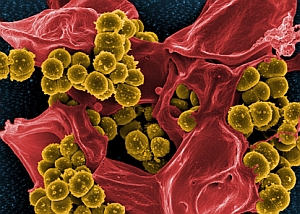Epidemiologists and mathematicians at Princeton University in New Jersey developed a computer model of methicillin-resistant Staphylococcus aureus (MRSA) transmission that shows the two leading forms of the bacteria will both continue to exist, without one dominating the other. The team working under the direction of population biologist Bryan Grenfell published its findings online in a recent issue of the journal PLoS Pathogens.
MRSA is an antibiotic-resistant bacterium that causes diseases ranging from skin and soft-tissue infections to pneumonia and sepsis. The pathogen has traditionally been found in health care institutions, but in the past decade the bacterium has emerged in schools, athletic facilities, and residences. The newer community form of MRSA, while spreading rapidly, is a different genetic strain than the hospital-based MRSA bacteria, which are difficult to treat and resistant to a greater variety of antibiotics.
The Princeton team — two of the three researchers have since moved on to other institutions — constructed a mathematical model to forecast the competition between both MRSA forms and gauge if either form would become dominant. The model drew on nationwide databases to compile and integrate data on MRSA contracted by hospital patients, broken by age categories.
For the community MRSA data, Grenfell and colleagues used data from ambulatory medical surveys of physicians and outpatient medical services. The model also included data on antibiotic prescriptions for hospital- versus community-based MRSA drugs.
Based on the compiled data, the models developed by the team show the drugs prescribed in the hospital to combat both forms of MRSA were somewhat more effective than drugs used in the community. The hospitals’ more aggressive strategies, the model projected, will allow health care strains to survive despite competition from community MRSA strains. Those strategies, according to the model, will treat patients with the community strain more successfully when they visit hospitals, and thus prevent the community strains from spreading to more patients outside the hospital.
While MRSA remains a scourge, whether in hospitals or in communities, the finding that both strains will continue to exist is somewhat reassuring news. While recent studies show the number of patients with the community strain of MRSA growing and the hospital-based strain remained stable, the community strain was feared to become more dominant because of its lower cost of resistance. Grenfell’s model suggests the pathogen can be contained once it encounters the more hospitals’ aggressive treatments.
Read more:
- Informatics Tools Underused to Fight Hospital Infections
- U.S. Patent Issued for Anti-Super Bug Disinfectant
- Robotic Device Reduces Drug-Resistant Hospital Infections
- Simulator Shows Blood Stream Bacterial Formation
- UCLA to Study Copper Surfaces to Reduce Hospital Infections
* * *


 RSS - Posts
RSS - Posts
You must be logged in to post a comment.